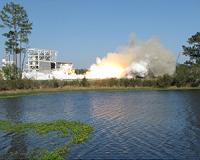 |
Mojave CA (SPX) Mar 23, 2011 United Launch Alliance (ULA) and XCOR Aerospace have announced their successful hot-fire demonstrations of a lighter-weight, lower-cost approach to liquid-fueled rocket-engine vacuum nozzles. The new nozzle technology, which uses aluminum alloys and innovative manufacturing techniques, is projected to be less costly and save hundreds of pounds of mass compared to nozzles in use today in typical large upper-stage rocket engine systems. Under a 2010 joint risk-reduction program by XCOR and ULA, ULA facilitated an accelerated demonstration of the nozzle technology, which was developed in XCOR's Lynx reusable, suborbital-vehicle technology program. ULA sought to determine the nozzle technology's applicability to future expendable launch vehicle programs. Earlier in the same risk-reduction program, XCOR demonstrated the ability to pump liquid hydrogen (LH2) using cryogenic piston-pump technology it developed for the Lynx suborbital vehicle. Based on the results of these successful technology demonstrations, ULA has announced a larger follow-on program with XCOR to develop a liquid oxygen (LOX)/LH2 engine. Conceived as a lower-cost, risk-managed program compared to traditional engine development efforts, the multi-year project's main objective is to produce a flight-ready LOX/LH2 upper-stage engine in the 25,000 to 30,000 lbf thrust class that costs significantly less to produce and is easier to operate and integrate than competing engine technologies. If successful, the effort will lead to significantly lower-cost and more-capable commercial and US government space flights delivered by ULA. "ULA understands that we have to offer competitive prices to our government and commercial customers along with the outstanding and unmatched reliability they expect from us," said Dr. George Sowers, vice president of business development and advanced programs at ULA. "By working with XCOR, we see the potential to develop engines that offer the performance and reliability our customers need at a more affordable price." The companies structured their LOX/LH2 engine development program with multiple "go / no-go" decision points and performance milestones to ensure a cost-effective and risk-managed approach to this challenging effort. As demonstrated during prior ULA and XCOR joint engagements, XCOR's small-company environment facilitates rapid turnaround for build and test cycles that drive innovative learning, while ULA's small company project management approach ensures their needs are met but does not stifle the creative process or saddle XCOR with excessive paperwork burdens typical of large government contracts. In addition, ULA is helping to bolster the Tier 2 and Tier 3 aerospace-industrial supply chain in the United States, which is critical to ensuring the United States aerospace sector remains competitive in the global marketplace. "This announcement validates XCOR's business mantra of 'stay focused on propulsion, Lynx and the customer' and ULA is a great customer," said Andrew Nelson, Chief Operating Officer at XCOR. "And when you have innovative, safe, low-cost and fully reusable technologies that fly multiple times a day, those technologies will find other buyers, such as ULA. Whether it is non-toxic thrusters, fully reusable main-engine propulsion, cryogenic flight-weight piston pumps, or non-flammable cryogenically compatible composite tanks and structures - the future looks bright for XCOR." The demonstrations announced are from integrated engine/nozzle test firings with XCOR's Lynx 5K18 LOX/kerosene engine. The engine/nozzle combination demonstrates the ability of the aluminum nozzle to withstand the high temperatures of rocket-engine exhaust over numerous tests, with no discernable degradation of the material properties of the alloys. The tests validated the design, materials and manufacturing processes used in the nozzle, and laid a foundation for scaling the design to EELV-sized engines. The results also demonstrate the reusability of the engine and nozzle combination which is essential for low-cost, daily suborbital flights by the Lynx and other vehicles. "We are honored to work with the great team of individuals at ULA, a Tier 1 aerospace supplier," said Jeff Greason, XCOR CEO. "The critical engine technology we're developing for ULA may one day launch satellites, capsules and space stations for government and commercial customers. Customers such as the US Air Force, NASA, the National Reconnaissance Office, Boeing and Bigelow Aerospace all stand to benefit from this partnership. For a rocket engineer, there is nothing more exciting than firing a new engine for the first time. We can't wait for the day when we first fire the new hydrogen engine for ULA."
Share This Article With Planet Earth
Related Links United Launch Alliance XCOR Aerospace Rocket Science News at Space-Travel.Com
 Commercial Rocket Engine Testing Continues At NASA Center
Commercial Rocket Engine Testing Continues At NASA CenterStennis Space Center MS (SPX) Mar 22, 2011 NASA's Stennis Space Center is moving ahead in supporting Orbital Sciences Corporation testing of Aerojet's AJ26 engines for commercial cargo flights to the International Space Station. Orbital plans to launch the first of eight scheduled unmanned cargo missions to the ISS in early 2012. Key steps already have been taken toward that goal as Orbital has successfully tested the Aerojet AJ26 ... read more |
|
| The content herein, unless otherwise known to be public domain, are Copyright 1995-2010 - SpaceDaily. AFP and UPI Wire Stories are copyright Agence France-Presse and United Press International. ESA Portal Reports are copyright European Space Agency. All NASA sourced material is public domain. Additional copyrights may apply in whole or part to other bona fide parties. Advertising does not imply endorsement,agreement or approval of any opinions, statements or information provided by SpaceDaily on any Web page published or hosted by SpaceDaily. Privacy Statement |